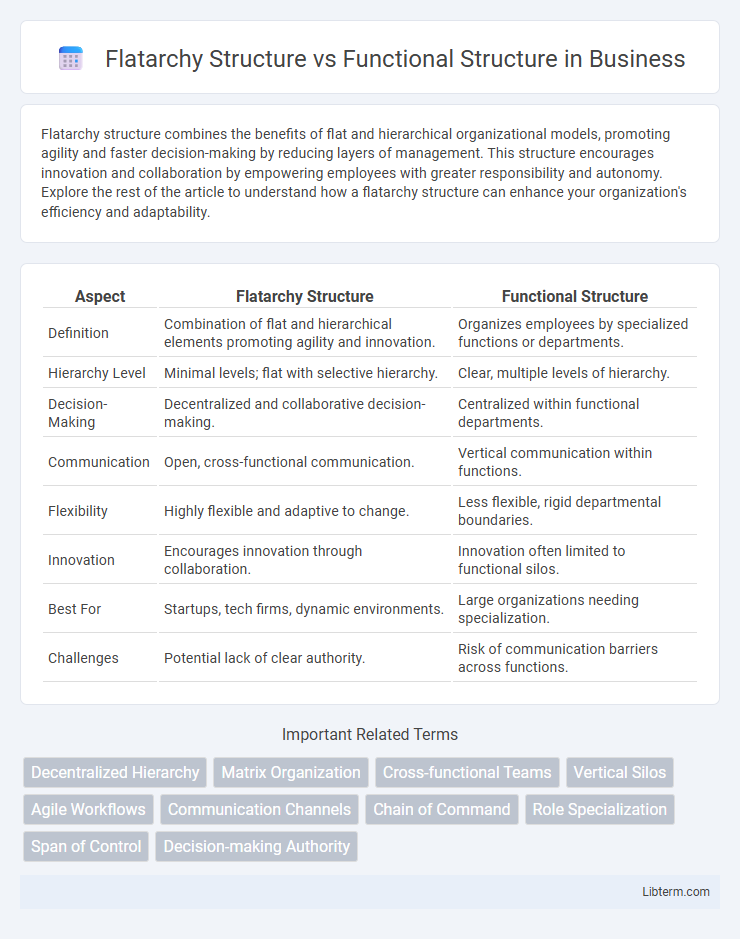Flatarchy structure combines the benefits of flat and hierarchical organizational models, promoting agility and faster decision-making by reducing layers of management. This structure encourages innovation and collaboration by empowering employees with greater responsibility and autonomy. Explore the rest of the article to understand how a flatarchy structure can enhance your organization's efficiency and adaptability.
Table of Comparison
| Aspect | Flatarchy Structure | Functional Structure |
|---|---|---|
| Definition | Combination of flat and hierarchical elements promoting agility and innovation. | Organizes employees by specialized functions or departments. |
| Hierarchy Level | Minimal levels; flat with selective hierarchy. | Clear, multiple levels of hierarchy. |
| Decision-Making | Decentralized and collaborative decision-making. | Centralized within functional departments. |
| Communication | Open, cross-functional communication. | Vertical communication within functions. |
| Flexibility | Highly flexible and adaptive to change. | Less flexible, rigid departmental boundaries. |
| Innovation | Encourages innovation through collaboration. | Innovation often limited to functional silos. |
| Best For | Startups, tech firms, dynamic environments. | Large organizations needing specialization. |
| Challenges | Potential lack of clear authority. | Risk of communication barriers across functions. |
Introduction to Organizational Structures
Flatarchy structure combines flat and hierarchical elements to enhance innovation and agility by reducing layers of management, fostering faster decision-making and collaboration across teams. Functional structure organizes a company based on specialized departments such as marketing, finance, or operations, promoting operational efficiency through clear roles and responsibilities but potentially creating silos. Choosing the right organizational structure depends on company size, industry, and strategic goals to balance control, flexibility, and communication effectively.
What is a Flatarchy Structure?
A Flatarchy structure combines elements of flat and hierarchical organizations, promoting flexibility and faster decision-making by reducing layers of management while maintaining clear roles. It encourages collaboration, innovation, and employee empowerment across teams, breaking down traditional departmental barriers typically found in functional structures. This hybrid model supports agile project execution and adapts quickly to changing business environments.
Key Features of Flatarchy Organization
Flatarchy structure combines a flat hierarchy with cross-functional teams to promote agility, faster decision-making, and innovation within organizations. Key features include minimal layers of management, collaborative workgroups that span different departments, and an emphasis on transparency and employee empowerment. This structure enhances flexibility and responsiveness, making it suitable for dynamic, fast-paced business environments.
Defining the Functional Structure
The functional structure organizes a company into departments based on specialized functions such as marketing, finance, or operations, promoting efficiency and expertise within each division. This hierarchy enhances clear reporting lines and role clarity but may lead to siloed communication and reduced cross-department collaboration. Compared to a flatarchy structure, which emphasizes agility and cross-functional teamwork, the functional structure prioritizes operational specialization and stability.
Main Characteristics of Functional Structure
Functional structure organizes a company into departments based on specific functions such as marketing, finance, and operations, promoting specialization and operational efficiency. This hierarchical model emphasizes clear roles, defined reporting lines, and centralized decision-making within each functional area. It enables deep expertise development but may limit cross-departmental communication and agility compared to flatter organizational designs like flatarchy.
Flatarchy vs Functional Structure: Core Differences
Flatarchy structure combines flat hierarchy and networked teams, promoting agility, faster decision-making, and cross-functional collaboration. Functional structure organizes employees based on specialized roles and departments, enhancing expertise but often slowing communication and adaptability. Flatarchy excels in innovation and flexibility, while functional structure prioritizes operational efficiency and clear authority chains.
Advantages of Flatarchy Structure
Flatarchy structure enhances organizational agility by combining the flat hierarchy's streamlined decision-making with the networked communication of a hierarchy, enabling faster innovation and responsiveness. It fosters cross-functional collaboration, breaking down silos inherent in functional structures, which improves creativity and problem-solving efficiency. Employee empowerment and reduced management layers lead to higher motivation and quicker adaptation to market changes.
Benefits of Functional Structure
Functional structure enhances organizational efficiency by grouping employees based on specialized roles, leading to improved expertise and streamlined workflows. Clear hierarchies within this structure enable better supervision, accountability, and consistent performance management. It also facilitates resource optimization by allowing departments to focus on core competencies and reduce duplication of efforts.
Challenges and Limitations of Each Structure
Flatarchy structures face challenges in scalability and role ambiguity, often leading to decision-making conflicts and lack of clear authority in larger organizations. Functional structures encounter limitations in interdepartmental communication, resulting in siloed teams and slower innovation processes due to rigid hierarchies. Both structures require careful management to balance flexibility with clarity and coordination for optimal organizational performance.
Choosing the Right Structure for Your Organization
Choosing the right organizational structure hinges on balancing flexibility and specialization to meet business goals effectively. Flatarchy structures promote innovation and faster decision-making by reducing hierarchical layers, ideal for dynamic startups or project-based environments. Functional structures enhance expertise and operational efficiency through department specialization, best suited for large, stable organizations with clear, routine workflows.
Flatarchy Structure Infographic

 libterm.com
libterm.com